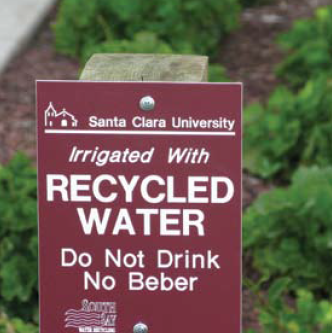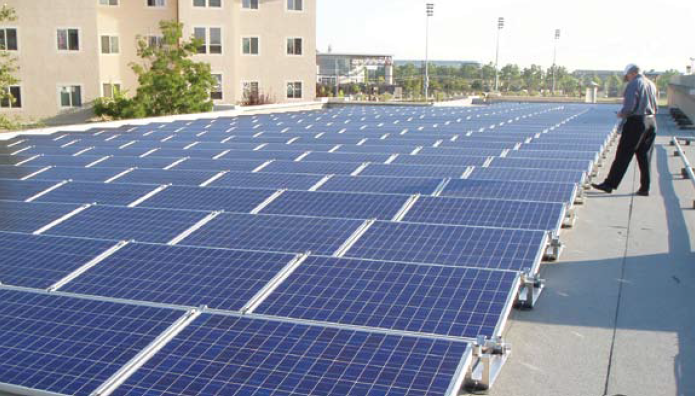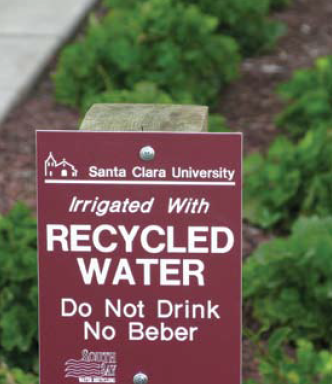
Where is Sustainability Happening at SCU?
A Culture of Sustainability As a Jesuit University, SCU has a mission for students , staff, and faculty to be engaged with society and be committed to fashioning a more humane, just, and sustainable world. We are dedicated to ensuring every SCU student graduates with “a culture of sustainability.” Sustainability is not achieved simply by “greening” campus operations. Developing a culture of sustainability means embedding this ethical philosophy across our campus, including the food we serve, the way we interact with the community, the decisions we make as individuals, and the way we teach.
Educating students to change the world
How do we create a culture of sustainability in our curriculum? At Santa Clara, we believe that sustainability is not the property of one department or one major but instead has to be owned by everyone. Rather than create a check-box “sustainability” requirement, SCU is integrating sustainability into many disciplines, in the same manner as it appears in the real world. The Penstemon Project, a peer-led faculty workshop in 2007, showed faculty how to integrate sustainability into their existing courses. Currently, 19 academic departments offer sustainability-related courses. Students in communication created documentaries about sustainability on campus, sociologists assessed barriers to greening campus offices, economists conducted cost/benefit analyses of implementing smart power strips at residence halls, and biologists explored the ethics of genetically modified crops. The sustainability pathway in the new core curriculum will enable students in business, engineering, and the arts and sciences to integrate sustainability into their studies.

Our students realize the opportunities and challenges facing their generation, many of which involve finding solutions to economic, environmental, and social problems. And at SCU, our students have myriad hands-on ways to explore solutions to these challenges. For instance, SCU was one of 20 schools in the 2007 Solar Decathlon, an international competition to design, build, and operate an energy-efficient, sustainable, solar-powered home. More than 100 SCU undergraduates’ efforts led SCU to earn third place.
The School of Engineering’s Center for Sustainable Studies strives to quantify sustainability. Faculty and students at the Center are committed to enabling sustainability through well-defined and rational metrics, system integration synergies, technologies to inform consumption choices, and industry/ University collaboration to build on and enable sustainable living.
The Environmental Studies Institute (ESI) offers majors in environmental science and studies, and the number of students in those majors has exploded from only five majors in 2000 to more than 100 in 2009. ESI houses the Office of Sustainability, the Penstemon Project, Sustainable Living Undergraduate Research Project (SLURP), the core curriculum sustainability pathway, and multiple community outreach programs.
The Campus as a Living Laboratory
Not only are students involved in sustainability academics, but more and more faculty are conducting research related to sustainability. In 2007-08, more than 25 percent of Santa Clara’s internal research funds were devoted to sustainability research. In 2009, SCU will launch a strategic research initiative focused on sustainability. The initiative will be coordinated by the Office of Research Initiatives, ESI, and the Center for Science, Technology, and Society. Faculty and students who are actively engaged in sustainability research will be invited to participate in reading groups, a colloquium
A Brief Timeline of Sustainability at SCU
2004 Santa Clara University adopted a Comprehensive Policy on Sustainability, devoting the University to sustainability through stewardship, education, and outreach.
2005 SCU’s commitment to sustainability was highlighted in the strategic plan as one of SCU’s “Future Directions.”
2006 Lindsey Cromwell ’04 was hired as the University’s first sustainability coordinator. One of her first tasks was to interview champions and stakeholders on campus: the individuals whose passion and dedication laid the groundwork and set the standard for sustainability at SCU.
2007 The first Campus Sustainability Assessment was completed. University President Paul Locatelli, S.J. became a signatory of the American College and University Presidents’ Climate Commitment, declaring the University will develop a plan to reach climate neutrality.
2008 The Office of Sustainability was formally established to support campus efforts, coordinate initiatives, serve as the clearinghouse for campus sustainability data, and to showcase University sustainability programs to the public. The Sustainability Council was also formed at this time to guide the efforts of the Office of Sustainability.
series, writing retreats, and opportunities to form interdisciplinary research teams.
SLURP provides undergraduates opportunities to conduct research on sustainability as it relates to residence life. SLURP is a joint project of ESI and CyPhi, the residential learning community focused on sustainability and the arts, which houses 20 percent of all campus residents.
In SLURP’s inaugural year, one research group studied energy conservation as it relates to behavior change. The group explored a variety of actions, from turning off lights in unoccupied restrooms to unplugging microwaves when not in use. They tracked Swig Hall’s energy consumption and reported back to residents each week, showing their energy consumption patterns to identify the weekly action with the highest participation levels (i.e. was it convenient?) and largest amount of energy conserved.
Their results: students in Swig conserved the most energy when they plugged their electronic appliances into smart power strips, a device that breaks the electric connection between appliances and the wall socket when they are not in use. Based on their study, the SLURP research group was able to quantify the amount of energy conserved and convert it to dollars saved. At their research exposition in May 2008, Assistant Vice President for University Operations Joe Sugg decided to implement these devices on a larger scale—faculty members in Lucas Hall, the University’s new business school building, were offered smart power strips as they moved into their new offices.
Energy Conservation
A key component to developing a culture of sustainability is literally modeling the way. The SCU Facilities Department is the lifeblood of our campus sustainability. We are able to integrate sustainability into academics because our campus operations lead the way. A key example: the University is dedicated to becoming a climate neutral campus. A major factor in reaching climate neutrality involves reducing our greenhouse gas emissions. Energy, in the form of electricity and natural gas, is the primary contributor to our campus’ greenhouse gas emissions.
University Operations targeted our buildings as opportunities to use energy more efficiently. Retrofits to existing buildings improve their mechanical efficiencies, while new buildings are designed to be as energy efficient as possible.
A great example of sustainable design in practice is the Commons at Kennedy Mall. Building occupants are well aware of the Commons’ unique design features because they are visible: peek-through windows showcase straw bale and denim insulation, the rooftop is covered with plants, and placards on the walls highlight other not-so-visible sustainable design elements. Kennedy Commons is not the only “green” building on campus. Since 2006, all new construction has been based on sustainable design principles. SCU’s latest expansion will be a Leadership in Energy and Environmental Design (LEED) Silver building—the Paul L. Locatelli, S.J. Student Activity Center, which was partially funded by a $7 million gift from Mary Mathews-Stevens ’84 and her husband, Mark. The University hopes to break ground on that project next year.
Though twice the size of the former Orradre Library building, the new Harrington Learning Commons, Sobrato Technology Center, and Orradre Library use about the same amount of energy. This is achieved through passive lighting (more than 90 percent of the public space in the building has access to natural light), under-floor air distribution, and automatic lighting sensors.
Lucas Hall was built using LEED guidelines to reduce energy consumption. It boasts many energy-efficient features, including
• “low-e glass” windows that reduce heat from the sun without reducing light
• energy-efficient heating and air conditioning
• motion-sensitive lighting
• carpet tiles on 35,083 square feet of the building. These enable easy replacement of stained tiles, rather than removal of an entire section of carpeting.
• classroom chairs made of recyclable materials
The Facilities Department is always looking for new technologies to improve the sustainability of our campus. The Support Services Building is currently testing interior lighting that uses one-third less electricity than equivalent fluorescent bulbs, as well as highly reflective exterior paint said to reduce a building’s cooling costs by more than 20 percent.
The University has also increased its commitment to supporting renewable energy: SCU purchases 11,256 mW-hrs of renewable wind energy from Silicon Valley Power. This amount is equivalent to the annual output of three and a half wind turbines.
Saving water … one flush at a time
Most urinals on campus no longer flush, and it’s not as unsanitary as it might sound. Actually, some say it’s more hygienic because there is no need to touch anything. Over 200 waterfree urinals have been installed throughout campus, and each conserves roughly 40,000 gallons of water per year through a passive-flush system. More recently, women have the opportunity to participate in water conservation-via-flushing: SCU is pilot testing dual-flush toilets in the Malley Center’s women’s restroom. These toilets allow users to determine the amount of water needed to flush. A low-flow flush uses up to two-thirds less water than a typical flush.
Also, the University has expanded its use of recycled water—previously-used water that has been treated for re-use for non-potable needs. Not only is 85 percent of our campus irrigated with recycled water, but all toilets in the Harrington Learning Commons, Sobrato Technology Center, and Orradre Library are flushed with recycled water.
Waste Minimization
The culture of sustainability regarding waste minimization is most crucial at the level of the individual. The University can (and has) set up the infrastructure to recycle, but the ultimate decision to recycle a soda can or water bottle is made by the individual. Besides placing clearly marked containers in convenient locations, how can we further encourage recycling beyond our current 20 percent diversion rate?
A classifieds website facilitates re-use of materials and furniture, so students, faculty, and staff can post and search for items. Waste reduction programs during campus move-out divert approximately 10 tons of waste, with items donated to local charities or stored and re-sold to incoming students in the fall. Roughly 90 percent of construction and demolition waste from the Learning Commons was recycled.

Initiatives, directed by our undergraduate recycling intern, inform the campus community about recycling procedures and encourage participation in waste reduction. These initiatives include instructional and educational signage for residence hall recycling/waste areas, recycle trivia competitions, a website with frequently asked questions, and a Facebook group for students to interact and sign up for events.
The University is currently developing a composting system that will initially focus on dining waste in Benson Center, our main oncampus student dining area. Our ultimate goal is to transform it into a zero-waste dining facility. Besides reducing waste associated with food preparation, our University catering company, Bon Appétit, fosters sustainability by serving local and organic produce (up to 80 percent seasonally), fair-traded coffee, sustainable seafood, antibiotic-free meats, and cage-free and certified humane eggs. Vegan and vegetarian options are offered at every meal. Dining Services has replaced disposable to-go containers and utensils with more environmentally friendly options featuring biodegradable materials.
Fostering a culture of sustainability beyond our campus boundaries
Spearheaded by Meghan Mooney ’09 (the Communications and Community Outreach Coordinator for Santa Clara’s 2006–07 Solar Decathlon team—see her essay on Page 26), SCU undergraduates developed the Sustainability Decathlon–a high school outreach component of the Solar Decathlon. Our students mentor local high school students as they explore sustainability and “green” their campuses in 10 categories. Three schools participated in the inaugural 2007 Sustainability Decathlon, and seven high schools are participating in the 2009 competition. Being a mentor for the Sustainability Decathlon requires SCU students to internalize the ideals of sustainability so they may teach and model those values to others.
The SCU Environmental Studies Institute (ESI) is leading the development of a new halfacre education, demonstration, and community garden one block north of campus. The garden will be used as a living laboratory and training facility for the Bronco Urban Garden (BUG) Program, which helps communities and schools in low-income neighborhoods in San Jose build and utilize new gardens.
Now onward …
We have made great strides as a University to integrate sustainability into our academics, operations, and outreach. We strive to develop a culture of sustainability, but what does a culture of sustainability feel like? How do we know when we have truly developed a culture of sustainability?
Thanks to Meghan Mooney’s research (described in her article in this issue), we have a better idea of what our students value and identify with. We can continue to work on bringing the sustainability movement to each campus community member and to encourage our students to enrich the world around them. College is a time of discovery, learning about who you are and how you fit into the world around you. What better time to consider how your actions and decisions affect others?